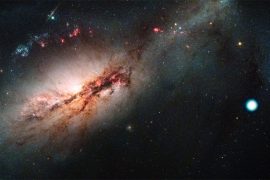Meaningful point of light: Astronomical observations show for the first time that massive gas planets can also form at great distances from their star through the direct collapse of gas. Evidence of this is provided by a young gas planet around the star AB Aurigae, which is 520 light-years away and orbits its star at a distance of 90 astronomical units. So it is far away that it has been created by the classic accretion of dust and fragments, as the researchers report in the journal “Nature Astronomy.”
Earth and most of the other planets in the Solar System were formed by accretion – the slow accumulation of dust and large fragments. Until now, however, it has been disputed whether this mechanism planet formation The same applies to gas planets orbiting forward, such as Jupiter or Saturn. Because not enough dust was actually available as a building material at this distance from the Sun, they could also have formed from the local collapse of gases – similar to the formation of stars. However, no evidence of this has been found so far.
even with some exoplanets Astronomers wonder how they could have formed. Because these young gas giants sometimes orbit 50 to 200 astronomical units from their star and are thus in the relatively thin, material-poor region of their protoplanetary disk. Because the protoplanet shown earlier PDS 70B But since they were several million years old, astronomers cannot rule out the possibility that they once formed and then moved outward.
young, heavy and far from the stars
Astronomers led by Thayne Curry of Japan’s National Astronomical Observatory may have discovered clear evidence of the distant orbiting gas giant’s formation at the site. Using the Subaru Telescope and the Hubble Space Telescope in Hawaii, they took a closer look at the young stars AB Aurigae, 520 light-years away. In this case, telescopes had previously found evidence of at least one planetary embryo.
The new recording confirms this. They show a distinctive bright point of light that is about 93 astronomical units from its star – it orbits about three times farther than Neptune in our solar system. The protoplanet, called AB Aurigae b, weighs about nine times the mass of Jupiter and is about three times the size of Jupiter. From the spectral characteristics of the light point, the team also concludes that it must be a protoplanet about one million years old. “Thus it represents an earlier stage in planet formation than the PDS-70 system,” the astronomers say.
Characteristics support construction by collapsing gas
Also interesting: The protoplanet is close to one of those spiral arms that cut through the gas and dust disk around the young star. “AB aurigae B appears as a distinct clump around these arms,” the team said. “Thus, the characteristics of this protoplanet are very similar to models of planet formation through gas instability.” According to these models, such spiral turbulence may have occurred as a result of the local collapse of gas in the protoplanetary disk.
This is supported by another observation by astronomers: telescope images show two points of light further out, which may have come from other planetary embryos. At a distance of 430 and 580 astronomical units, these young planets are even further away from their star. So they also probably were not made of classical accretion.
A new perspective on “our” gas giants?
“This evidence for at least one protoplanet at a great distance from AB Aurigae has important implications for our understanding of planetary formation,” Currie and colleagues said. “AB Aurigae b may give us the first direct evidence that Jupiter-like planets may have formed from gas instability.”
If confirmed, it would also shed new light on the formation of gas giants in our own solar system. For Jupiter and Saturn as well, it is disputed whether they were created by local gas collapse rather than by accretion. (Nature Astronomy, 2022; doi: 10.1038/s41550-022-01634-x,
Source: Nature Astronomy

Internet fan. Alcohol expert. Beer ninja. Organizer. Certified tv specialist. Explorer. Social media nerd.





